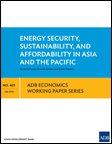World Energy Outlook 2017This report looks at large-scale shifts in the global energy system, such as the the growing electrification of energy and the rise of renewables, and discusses how these shifts interact with each other. It also examines how India and other major developing countries are blurring the distinctions between energy producers and consumers. Author: International Energy Agency Year: 2017 Download Tags: Energy, India, Renewable Energy, Renewables Sri Lanka Energy Sector Development Plan For A Knowledge-Based Economy, 2015-2025Sri Lanka has set an set an ambitious goal of 100% energy self-sufficiency by 2030. With annual total electricity demand estimated at 10,500 gigawatt hours—increasing annually by around 4-6%—and challenges including high cost of electricity, 100% dependence on imported oil for the transport sector, and need for large investments in infrastructure, this book unveils how the energy sector plans to achieve energy security in the next 10 years—envisioning a future where clean, reliable, affordable energy is made available 24/7 to the whole country. This sector development plan for a knowledge-based economy aims to provide a balance between the country's energy demand and supply, and its long-term perspective anchored on continuous economic growth, through renewable and indigenous sources of energy. Author: Sri Lanka Ministry of Power and Energy Year: 2015 Download Tags: Energy, Sri Lanka, Renewables World Energy Outlook 2015Global energy is undergoing major changes. Renewables are increasingly contributing to the the world’s power generation capacity, and coverage of mandatory energy efficiency regulation worldwide has expanded to more than a quarter of global consumption. This World Energy Outlook 2015 provides insights to policy-makers, industry and other stakeholders on the state of the energy sector today, discussing which changes are transient or cyclical, the risks and opportunities that may lie ahead, and actions that can put the energy system on a more secure and sustainable footing. It also includes a special chapter discussing India’s energy outlook, and how development in India's energy sector over the coming decades will impact the country and the global energy system as a whole. Author: International Energy Agency Year: 2015 Download Tags: Energy, India, Renewables  Energy Security, Sustainability, and Affordability in Asia and the PacificEnergy security, sustainability, and affordability from 2010 to 2035 for Asian Development Bank’s Asia and Pacific members are calculated in this working paper, including potential benefits of integrating energy systems regionally. Based on business-as-usual and alternative scenarios, outlook on SASEC member countries by 2035 include (i) dramatic improvement in Bhutan's energy efficiency, (ii) slight decrease in Bangladesh's energy intensity—although carbon dioxide will increase in its primary energy mix, as dependence on fossil fuels rise, and (iii) decrease in energy self-sufficiency of SASEC member countries by 2035, but improved energy affordability. Since renewable energy sources and importation of energy may be capital-intensive, requiring additional tariff support, regional cooperation can enhance affordability and energy security—with Bhutan and Nepal standing to benefit greatly from energy integration in South Asia. Author: Norberto Fueyo, Antonio Gómez, and César Dopazo Year: 2014 Download Tags: Energy, Bhutan, Nepal, Sustainability, Asia-Pacific, ADB, Regional Integration, SASEC, South Asia, Bangladesh, Sustainability, Renewables, Tariff, Regional Cooperation SAARC Biz: The Inevitability of South Asia SAARC Biz is a monthly publication of the SAARC Chamber of Commerce & Industry and features a report on the 'Inevitability of South Asia'. While the term 'South Asia' is commonly accepted, it argues that regionalism is far from being implemented on the ground. For instance, SAARC was accepted as a concept of cross-border regionalism but was hobbled due to budget constraints and restrictive mandates. Connectivity across national frontiers is needed to jump-start regionalism and improve lives in the most deprived parts of the Subcontinent. Author: SAARC Chamber of Commerce and Industry Year: 2014 Download Tags: South Asia, Regional Cooperation, SAARC, Industrialization, Regional Integration, Poverty Reduction, Gender, Least Developed Countries, Connectivity, Agriculture, Bangladesh, Youth, India, Environment, Investment, Tourism, Renewables Lose to Gain: Is Involuntary Resettlement a Development Opportunity?This book examines how displaced persons recover from physical and economic displacement in the South Asian context using resettlement case studies from India, Nepal, and Sri Lanka. Despite improvement in national policies and willingness to enforce good practices, the level of involuntary resettlement good practices in South Asia varies widely. There is need for greater commitment, legal reforms, and adequate resources to ensure that involuntary resettlement becomes a development opportunity for all project-affected persons. Author: Perera, Jayantha (ed.) Year: 2014 Download Tags: India, Nepal, South Asia, Resettlement, Bangladesh, Energy, Renewables, Sri Lanka, Transport Energy Outlook for Asia and the Pacific: October 2013The Energy Outlook for Asia and the Pacific aims to support ADB energy sector operations
by providing stakeholders with an energy outlook for the region up to the year 2035.
It attempts to identify policy, social, infrastructure, and technology issues that must be
addressed to meet future energy need of ADB members in Asia and the Pacific. Author: Asian Development Bank Year: 2013 Download Tags: Energy, Infrastructure, Renewables, Hydropower, Transport, Bangladesh, Bhutan, India, Nepal, Maldives, Sri Lanka |



